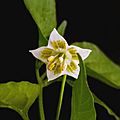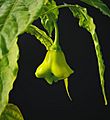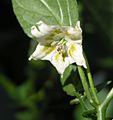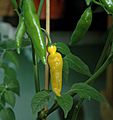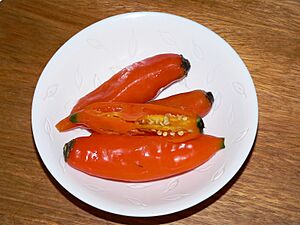Capsicum baccatum facts for kids
Quick facts for kids Capsicum baccatum |
|
|---|---|
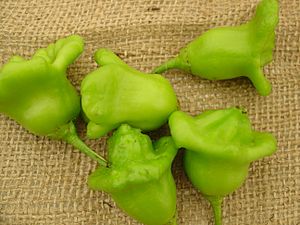 |
|
| Bishop's crown fruits | |
| Scientific classification | |
| Genus: |
Capsicum
|
| Species: |
baccatum
|
| Synonyms | |
|
|
Capsicum baccatum is a type of chili pepper plant. It is one of the five main kinds of chili peppers that people have grown for a long time. These peppers can be quite spicy! They usually score between 30,000 and 50,000 on the Scoville scale, which measures how hot a pepper is.
C. baccatum plants have white or cream-colored flowers. Their flowers are usually pollinated by insects or by themselves. The fruits of this pepper come in many different shapes and sizes. This is different from other chili pepper types that often have a special shape. The peppers usually hang down from the plant. They can also have a fresh citrus or fruity taste.
Contents
Where Do These Peppers Come From?
The C. baccatum species, especially the Ají amarillo chili, first grew in ancient Peru. It also grew across the Andes Mountains in South America. This pepper is a very important part of Peruvian cuisine. It is often used with red onion and coriander. The name Ají amarillo means "yellow chili." But the peppers are bright orange when they are ripe. They turn yellow when they are cooked.
How Are They Used in Cooking?
Yellow ají is a key ingredient in both Peruvian cuisine and Bolivian cuisine. It is used as a spice, especially in many dishes and sauces. In Peru, people mostly use fresh ají chilis. In Bolivia, they often use dried and ground ají.
Some popular dishes that use ají "amarillo" are the Peruvian stew Ají de gallina (which means "Hen Chili") and Papa a la Huancaína. In Bolivia, it is used in Fricasé Paceño. In Ecuadorian cuisine, ají amarillo, onion, and lemon juice are often served separately. People can add these to their meals if they want. In Colombian cuisine, Peruvian Cuisine, and Ecuadorian cuisine, ají (sauce) is also a common sauce.
Growing Capsicum baccatum
The cultivated C. baccatum (called C. baccatum var. pendulum) is the most popular pepper grown in Bolivia, Colombia, Ecuador, Peru, and Chile. The Moche culture, an ancient group of people, often showed fruits and vegetables in their art. This included Ají amarillo peppers. Farmers in South America also grow C. baccatum plants to sell as pretty ornamental plants.
What Does the Name Mean?
The word ají has been used for a very long time, since about 4600 BCE. It was first used in a very old language called Otomanguean. The word then spread along with the chili pepper from Central and South America to other places where peppers grow.
Capsicum baccatum is still called ají. Other peppers are called "pepper" because Spanish explorers thought their spiciness was like black pepper.
The Latin name Capsicum baccatum comes from two parts. Capsicum comes from the Greek word kapos. Baccatum means "berry-like."
Different Kinds of C. baccatum
This type of chili pepper includes several well-known kinds:
- Ají amarillo, also called amarillo chili or ají escabeche
- Bishop's crown
- Lemon drop, also known as ají limón or ají limo
- Piquanté Pepper
See also
 In Spanish: Capsicum baccatum para niños
In Spanish: Capsicum baccatum para niños


